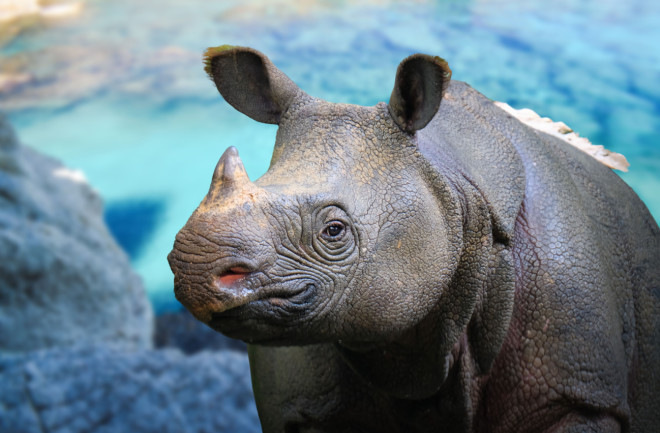Javan rhinos are among Earth's rarest large mammals, and once roamed from Northeast India to Southeast Asia. Yet despite tireless conservation efforts, these hefty herbivores are now teetering on the brink of extinction.
Getting a precise count of the few Javan rhinos left is critical to making decisions about their conservation. The elusive nature of these animals, however, combined with political complexities, complicate this essential task — and the clock is ticking.
Of course, the Javan rhino isn’t the first rhino to face extinction, nor would it be the first to recover from a near disappearance. Experts estimate that more than 100 rhino species have roamed the Earth, with a vast majority of them now extinct.
More recently, the southern white rhino, a subspecies of white rhino, was thought to be extinct in South Africa. However, at the end of the 19th century, a group of about 100 individuals was discovered.
Through well-coordinated conservation efforts, the white rhino rebounded and is currently the only rhino species whose populations are listed as “not threatened.” Whether the Javan rhino will follow the same path remains to be seen.
Day in the Life of a Javan Rhinoceros
Among the five living rhino species — two in Africa and three in Asia — only the Javan and greater one-horned rhinos have a single horn. Unlike some of the other species, however, Javan rhinos don’t use their horns for combat.
Instead, the stumpy, keratin appendage serves as a multitool. This allows the animals to scrape mud, forage for food and create trails in the forest underbrush.
Weighing as much as 5,000 pounds, these beasts maintain their rotund figures on a mostly vegetarian diet. By consuming over 100 pounds of twigs, leaves, shoots and fruits daily, they are the jungle’s built-in gardeners — pruning some plants to make room for others to grow.
Despite their impressive size, Javan rhinos manage to elude detection in their dense rainforest home. Apart from quick mating bouts and maternal care of young, these beasts prefer to go about life on their own.
Read More: The Last Of North America’s Great Rhinos That Evolved 55 Million Years Ago
Why Are Javan Rhinos Endangered?
For thousands of years, people hunted the species for its horns; these were, and continue to be, coveted in traditional medicine.
Demand for rhino horn skyrocketed around the mid-19th century, leading to decades of relentless poaching and steep population declines. After the last known Javan rhino in Vietnam fell victim to poachers in 2010, Ujung Kulon National Park in West Java, Indonesia, became the species’ last remaining refuge.
Some experts have concerns over housing the entire remaining population in just one location: A single catastrophe, such as a tsunami (which Indonesia is prone to) or disease outbreak, could spell swift extinction for the remaining rhinos.
But even without such a major event, the park itself may simply be too small to support any more rhinos — preventing the very population growth required to save the species.
While poaching was historically a significant threat to Javan rhinos, stringent protective measures have now greatly reduced this risk.
Read More: Can Conservationists Actually Save Rhinos by Dehorning Them?
How Many Javan Rhinos Are Left?
Today, the critically low population of Javan rhinos introduces its own set of challenges, as well: specifically, a high risk of inbreeding and low genetic diversity. This lack of genetic diversity could lead to the birth of less healthy individuals, reducing the population’s ability to recover and thrive.
Additionally, their habitat is under constant pressure from human activities, including illegal firewood harvesting and encroachment, which further reduce the rhinos' limited living space.
Because they like to keep to themselves, conservationists and park rangers use motion-activated cameras to monitor the population. Since the introduction of these cameras in 2011, the number of Javan rhinos has more than doubled to 72, according to the Indonesian government.
Read More: Scientists Are Trying to Save These Animals From Extinction
Rhino Conservation Under Scrutiny
Yet some groups are skeptical of these numbers. A report by Auriga Nusantara, an Indonesian NGO, for example, has made troubling allegations about the government’s handling of rhino monitoring.
According to that report, the Indonesian Ministry of Environment and Forestry has only incorporated positive information — like sightings of rhino babies — into their counts, while allegedly failing to account for rhinos that haven’t been seen in years and are likely dead.
Without accurate information on even the most basic aspects of Javan rhino populations, the future of the species looks bleak. Experts warn that the species could face extinction within the next decade.
Nonetheless, as the remarkable recovery of the southern white rhino over a century ago demonstrates, the situation is not without hope. With dedicated and sustained conservation action, there is potential for the Javan rhino to follow a similar path toward recovery and survival.
Read More: Why We May Be in the Midst of a Sixth Mass Extinction

